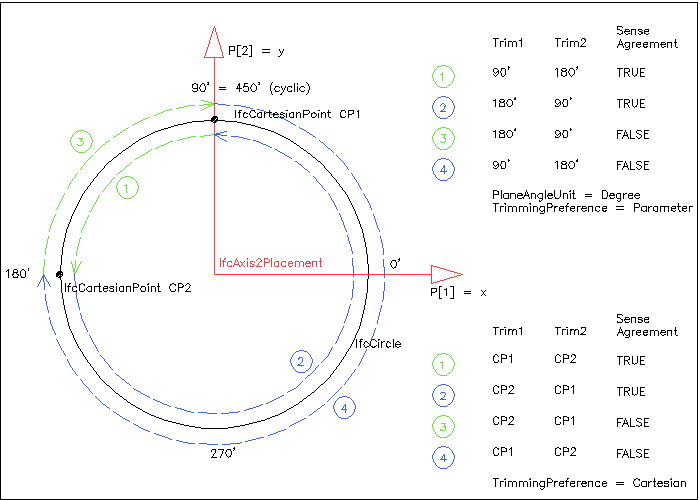
IfcTrimmedCurve
Definition from ISO/CD 10303-42:1992: A
trimmed curve is a bounded curve which is created by taking a selected
portion, between two identified points, of the associated basis curve.
The basis curve itself is unaltered and more than one trimmed curve may
reference the same basis curve. Trimming points for the curve may be
identified by:
- parametric value
- geometric position
- both of the above
At least one of these shall be specified at each end of the
curve. The SenseAgreement makes it possible to
unambiguously define any segment of a closed curve such as a circle.
The combinations of sense and ordered end points make it possible to
define four distinct directed segments connecting two different points
on a circle or other closed curve. For this purpose cyclic properties
of the parameter range are assumed; for example, 370 degrees is
equivalent to 10 degrees.
The IfcTrimmedCurve has a parameterization
which is inherited from the particular basis curve reference. More
precisely the parameter s of the trimmed curve is derived from the
parameter of the basis curve as follows:
- if SenseAgreement is TRUE: s
= t - t1
- if SenseAgreement is FALSE: s
= t2 - t
In the above equations t1 is the value
given by Trim1 or the parameter value corresponding
to point 1 and t2 is the value given by Trim2
or the parameter value corresponding to point 2. The resultant IfcTrimmedCurve
has a parameter ranging from 0 at the first trimming point to |t2
- t1| at the second trimming point.
NOTE In case of a closed curve,
it may be necessary to increment t1 or t2 by the parametric length for
consistency with the sense flag.
NOTE
Corresponding STEP entity: trimmed_curve; As a further IFC restriction,
an IfcTrimmedCurve should only trim a IfcLine
or IfcConic. Please refer to ISO/IS 10303-42:1994,
p. 54 for the final definition of the formal standard.
HISTORY
New class in IFC Release 1.0
Informal Propositions:
- Where both the parameter value and the Cartesian point
exist for Trim1 and Trim2 they
shall be consistent. (i.e., the BasisCurve
evaluated at the parameter value shall coincide with the specified
point.)
- When a Cartesian point is specified by Trim1
or by Trim2 it shall lie on the BasisCurve.
- Except the case of a closed BasisCurve
where both parameter 1 and parameter 2 exist, they shall be consistent
with the sense flag, i.e., (sense = parameter 1 < parameter 2). Or, for every open curve where both
parameter 1 and parameter 2 exist, they shall be consistent with the SenseAgreement,
i.e., SenseAgreement = (parameter 1 <
parameter 2).
- If both parameter 1 and parameter 2 exist, then parameter 1
<> parameter 2.
- When a parameter value is specified by Trim1
or Trim2 it shall lie within the parametric range
of the BasisCurve.
Additional illustration from IAI:
 |
The figure above shows the four arcs (dashed blue and
green lines with arrow showing different orientations) that can be
defined by the same BasisCurve (of type IfcCircle)
and the same trimming points (given by Cartesian points and parameter
values) by using different assignments to Trim1 and
Trim2 and SenseAgreement.
Note: Since the BasisCurve is closed (type IfcCircle),
the exception of the informal proposition IP3 applies, i.e. the sense flag is not
required to be consistent with the parameter values of Trim1
and Trim1, so the rule (sense = parameter 1
< parameter 2) may not be fulfilled.
|
EXPRESS specification:
|
|
|
|
|
|
| SenseAgreement
|
:
|
BOOLEAN;
|
|
|
|
| WR41
|
:
|
(HIINDEX(Trim1) = 1) OR (TYPEOF(Trim1[1]) <> TYPEOF(Trim1[2]));
|
| WR42
|
:
|
(HIINDEX(Trim2) = 1) OR (TYPEOF(Trim2[1]) <> TYPEOF(Trim2[2]));
|
| WR43
|
:
|
NOT('IFCGEOMETRYRESOURCE.IFCBOUNDEDCURVE' IN TYPEOF(BasisCurve));
|
|
|
|
Attribute definitions:
| BasisCurve
|
:
|
The curve to be trimmed. For curves with multiple representations any parameter values given as Trim1
or Trim2 refer to the master representation of the BasisCurve only.
|
| Trim1
|
:
|
The first trimming point which may be specified as a Cartesian point, as a real parameter or both.
|
| Trim2
|
:
|
The second trimming point which may be specified as a Cartesian point, as a real parameter or both.
|
| SenseAgreement
|
:
|
Flag to indicate whether the direction of the trimmed curve agrees with or is opposed to the direction
of the basis curve.
|
| MasterRepresentation
|
:
|
Where both parameter and point are present at either end of the curve this indicates the preferred form.
|
Formal Propositions:
| WR41
|
:
|
Either a single value is specified for Trim1, or the two trimming values are of different type (point
and parameter)
|
| WR42
|
:
|
Either a single value is specified for Trim2, or the two trimming values are of different type (point
and parameter)
|
| WR43
|
:
|
Only line and conic curves should be trimmed, not other bounded curves. NOTE: This is an additional constraint
of IFC.
|
Inheritance graph
|
|
|
|
|
|
| SenseAgreement
|
:
|
BOOLEAN;
|
|
|
|
